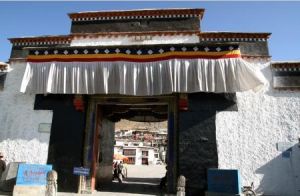Tashilhunpo Monastery
Situated at the foot of the Drolma (Tara) Mountain, 10 km west of Xigaze, Tashilhunpo Monastery is the biggest Monastery of Gelug Sect of Tibetan Buddhism in Tsang and is also the official seat of successive Panchen Lamas.
The monastery was established in 1447 by the First Dalai Lama Gedun Druppa, a disciple of Tsongkhapa, with the financial backing of Chungye-pa Sonam Paljor and other nobles of the Tsang region. When the Fourth Panchen Lama Lozang Choskyi Gyaltsen became tripa (abbot) of Tashilhunpo in 1600, he extended the monastery. It was also rebuilt and extended by successive Panchen Lamas to reach its current size. At its height Tashilhunpo was said to have housed as many as 4,000 monks.
The monastery complex is enclosed by some two kilometers of walls. It is composed of four dratsangs (colleges), namely, Shartse, Ngag-pa, Jikhang and Thosamling, and dozens of chapels and halls, such as the Maitreya Buddha Chapel, the Fourth Panchen Lama’s Chapel, the Chapel of the Fifth through Ninth Panchen Lamas, in which their joint chorten is preserved, the hall with the chorten of the Tenth Panchen Lama, the Tsogchen Hall (Assembly Hall), and the Han-style Chapel. The earliest building is the Tsogchen Hall, which contains the sacred seat on which the Panchens gave sermons.
The monastery houses images of Sakyamuni, Maitreya Buddha, Taras, Avalokiteshvara and Manjushri, as well as those of Tsongkhapa and his eight chief disciples.
On the hill at the back of the monastery stands a platform specially built for the annual displaying of Buddha’s portrait for monks and laymen to worship. The platform has become a symbol of the Tashilhunpo.
The Tashilhunpo Monastery boasts many valuable cultural relics of the Ming and Qing dynasties, including the portrait of Qing Emperor Qianlong in the Gyanag Lhakang, porcelain, enamel and glass vessels, embroidery and Thang-ga (Tangka) paintings. There are also pattra-leaf scriptures, the Kangyur and Tengyur Sanskrit classics written in gold, and the golden album, golden seal, imperial mandate and other documents bestowed by Qing emperors on the Panchen Lamas, in addition to many wall paintings of Sakyamuni and Tsongkhapa.
